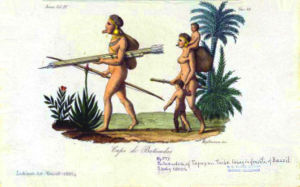- Botocudo people
-
Krenak
BotocudoTotal population 350 (2010)[1] Regions with significant populations  Brazil (Matto Grosso, Minas Gerais, São Paulo)
Brazil (Matto Grosso, Minas Gerais, São Paulo)Languages Krenak
Religion Botocudo (from Portuguese for botoque, a plug, in allusion to the wooden disks or tembetás worn in their lips and ears), is the foreign name for a tribe of South American Indians of eastern Brazil, also known as the Aimorés, Aimborés, or Krenak people. Some called themselves Nacnanuk or Nac-poruk, meaning "sons of the soil".
The Brazilian chief who was presented to King Henry VIII in 1532 wore small bones hung from his cheeks and from the lower lip a semi-precious stone the size of a pea. These were the marks of great bravery. When the Portuguese adventurer Vasco Fernando Coutinho reached the east coast of Brazil in 1535, he erected a fort at the head of Espírito Santo Bay to defend himself against the Aimorés and other tribes.
Contents
Distribution and fate
The tribe's original territory was in Espírito Santo, and reached inland to the headwaters of Rio Grande (Belmonte) and Rio Doce on the eastern slopes of the Serra do Espinhaço. The Botocudos were gradually expelled by European colonists westward beyond the Serra dos Aimorés into Minas Gerais. It was in the latter district that at the close of the 18th century they came into collision with the Europeans, who were attracted there by the diamond fields. At the end of the 19th century many Botocudo tribes still existed, numbering between 13,000 and 14,000 individuals. During the earlier frontier wars of 1790-1820, every effort was made to destroy them. Smallpox was deliberately spread among them; poisoned food was scattered in the forests; by such infamous means, the coast districts about Rio Doce and Belmonte were cleared, and one Portuguese commander boasted that he had either slain with his own hands or ordered to be butchered many hundreds of them. Today, only a few tribes remain, almost all of them in rural villages and Indigenous territories. The last remnants of the Eastern Botocudo are the Krenak. In 2010 ,there were 350 Krenak living in the State of Minas Gerais.[2]
Customs
 Botocudo man, drawn by Johann Moritz Rugendas
Botocudo man, drawn by Johann Moritz Rugendas
The Botocudos were nomadic hunter-gatherers, wandering naked in the woods and living from the forest. Their implements and domestic utensils were all of wood; their only weapons were reed spears and bows and arrows. Their dwellings were rough shelters of leaf and bast, seldom 1,5 m high. Their only musical instrument was a small bamboo nose-flute.[citation needed] They attributed all the blessings of life to the day-fire (Sun) and all evil to night-fire (Moon). At the graves of the dead, they kept fires burning for some days to scare away evil spirits, and, during storms and eclipses, arrows were shot into the sky to drive away demons.
The most conspicuous feature of the Botocudos was the tembeitera, a wooden plug or disk which is worn in the lower lip and the lobe of the ear. This disk, made of the specially light and carefully dried wood of the barriguda tree (Chorisia ventricosa), which was called by the natives themselves embur, whence Augustin Saint-Hilaire suggested that this could be the probable derivation of their name Aimboré (1830). It is worn only in the under-lip, now chiefly by women, but formerly by men also. The operation for preparing the lip begins often as early as the eighth year, when an initial boring is made by a hard pointed stick, and gradually extended by the insertion of larger and larger disks or plugs, sometimes at last as much as 10 cm in diameter. Notwithstanding the lightness of the wood the tembeitera weighs down the lip, which at first sticks out horizontally and at last becomes a mere ring of skin around the wood. Ear-plugs are also worn, of such size as to distend the lobe down to the shoulders. Ornaments of like nature are common in south and even Central America, at least as far north as Honduras, as described by Christopher Columbus when he discovered this latter country during his fourth voyage (1502). This ornament also named part of the Peru seaboard as Costa de la Oreja, from the conspicuously distended ears of the native Chimu. Early Spanish explorers also gave the name Orejones or big-eared to several Amazon tribes.
See also
- Indigenous people of Brazil
- History of Brazil
- Luzia
References
- ^ "Krenak: Introduction." Povos Indígenas no Brasil. (retrieved 23 June 2011)
- ^ Le chef brésilien qui fut présenté au roi Henri VIII, en 1532, portait des petits os suspendus aux pommettes des joues et à la lèvre inférieure une pierre fine grande comme un petit pois. C'étaient des marques d'une grande bravoure.- L'Art de verifier les dates , volume-36 printed in paris in 1770.
Sources
- P.M.A. Ehrenreich. "Ueber die Botocudos." Zeitschrift fur Ethnologie 19: 49-82. 1887.
- Maximilian von Wied Neuwied. Reise nach Brasilien in den Jahren 1815 bis 1817, v. 2., Frankfurt, 1820.
- Henri Hollard.De L'homme et des Races Humaines, Paris, 1853.
- A. H. Keane. "On the Botocudos." Journal of the (Royal) Anthropological Institute 13: 199-213. 1883.
- Charles C. Mann. 1491, Vintage Books, a division of Random House, New York, 2005. pg. 152-154.
- A. Metraux. "The Botocudo." Bulletins of the Bureau of American Ethnology 143: i, 531-540. 1946.
- Augustin Saint-Hillaire. Voyages dans l'intérieur du Brésil '816-1821, Paris, 1830.
 This article incorporates text from a publication now in the public domain: Chisholm, Hugh, ed (1911). Encyclopædia Britannica (11th ed.). Cambridge University Press.
This article incorporates text from a publication now in the public domain: Chisholm, Hugh, ed (1911). Encyclopædia Britannica (11th ed.). Cambridge University Press.External links
- Rudolph, Bruno. 1909. Wörterbuch der Botokudensprache. Hamburg: Fr. W. Thaden.
Categories:- Ethnic groups in Brazil
- Indigenous peoples of Eastern Brazil
Wikimedia Foundation. 2010.

